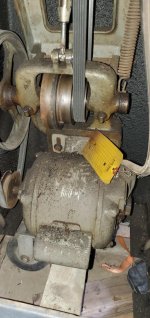Savedbygrace77
Aluminum
- Joined
- Jul 15, 2018
Hi all - so ive been familiarizing myself on the southbend since I picked it up 2 years ago.. ive learned alot but am still super green..
Embarrassingly ive noticed I am unable to make a cut without using the back gears - ive disabled the gearbox, everything is lubed and oiled- without back gears I cant even dream of even a 5 thou light cut unless I feed in pulses to give the chuck time to speed up- its beyond pitiful..
Ive tried the 2 slower speeds on the belt, ive cleaned the pulleys and currently using a ribbed v-belt I sewed to length.. I can hear the motor just laboring with the slightest of cuts / feed-
Is there a way to test the motor? Could I put new brushes in and check the armature? Weak magnets?
Option 2 is buy a late style servo motor and convert (with digital rpm and control knob) -
Thoughts?
Im sure this lathe is quite capable but Im pretty sure the motor is way under performing-
fwiw - im turning alu and steel anything from 2 inches thick to 8" wide spacers, I basically have to use back gears ALL the time to get anything out of it-
Embarrassingly ive noticed I am unable to make a cut without using the back gears - ive disabled the gearbox, everything is lubed and oiled- without back gears I cant even dream of even a 5 thou light cut unless I feed in pulses to give the chuck time to speed up- its beyond pitiful..
Ive tried the 2 slower speeds on the belt, ive cleaned the pulleys and currently using a ribbed v-belt I sewed to length.. I can hear the motor just laboring with the slightest of cuts / feed-
Is there a way to test the motor? Could I put new brushes in and check the armature? Weak magnets?
Option 2 is buy a late style servo motor and convert (with digital rpm and control knob) -
Thoughts?
Im sure this lathe is quite capable but Im pretty sure the motor is way under performing-
fwiw - im turning alu and steel anything from 2 inches thick to 8" wide spacers, I basically have to use back gears ALL the time to get anything out of it-




